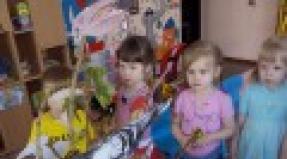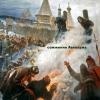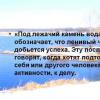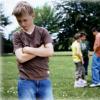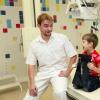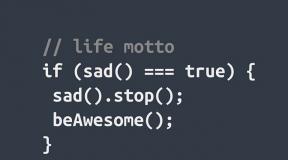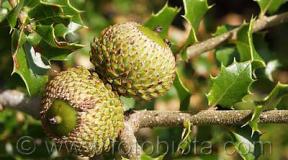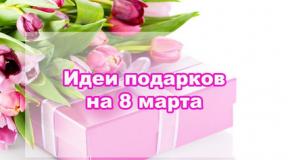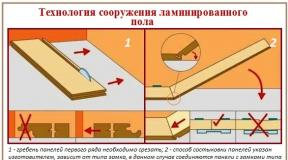Presentation on the theme of Orxe monastery. Presentation for the orkse lesson for primary classes "monastery". Monk habitat
1. Topic of the lesson: Lesson 4 of the course "Fundamentals of Orthodox Culture" Monastery.
2. Objectives of the lesson: to give students an initial idea of an Orthodox monastery, monks, to introduce the concept of prayer, Holy elders.
EDUCATIONAL GOALS: deepening knowledge about Orthodoxy.
DEVELOPING PURPOSES: to develop the moral qualities of a person, to develop communicative, informational competencies.
EDUCATIONAL PURPOSES: aesthetic, moral, labor education, love for the study of the subject. Form the skills of behavior in the monastery. To cultivate respect for the Holy Fathers. Raising love for the Motherland on the example of St. Sergius of Radonezh.
3. EQUIPMENT: textbook, visual aids, video tour, projector.
4. FORMS AND TYPES OF ACTIVITY: teacher's story, conversation, reading, work in pairs, groups, work with illustrative material (presentation), independent work on developmental tasks, participation in dialogue.
DURING THE CLASSES
UPDATE (5-7 minutes).
The teacher invites children to listen to an excerpt from the song "Monastery"
What do you think will be discussed today?
(Answers of children)
Teacher: Do you want to go on a virtual trip today?
What questions are we going to ask ourselves?
What is a monastery, how they live in a monastery, what is prayer, Holy Elders.
FORMATION OF SKILLS AND SKILLS:
The teacher shows children the tablets "Monastery", "Monks", "Cell", "Prayer", "Life in the Monastery", "Holy Elders".
Today we have to answer the questions that we have posed to ourselves.
The teacher hangs out the first card "Monastery"
What is a monastery? Who was in the monastery?
Children's answers.
The first slide with a photograph of the monastery appears.
A monastery is where heaven meets earth. This is what the soul of a person who has opened a modest wooden door feels. Separating the world and the monastery and stepping on its blessed land. Holy Elders.
A monastery is a special world, it has its own laws and rules. People come there to worship shrines, to cleanse their souls. Some people go for advice in difficult life situations, for healing from an illness. And some people associate their life with God and remain in the monastery to perform their feat of piety.
Who lives in the monastery and how?
Why do people go to monks?
What are the monks giving up?
(Answers of children).
Slide 2 appears (Photo of the monks)
A monk (nun) is a person who, due to his religious convictions and vocation, agreed to live without a family. He himself believes that he not so much refused as agreed: he agreed with a certain call from God, which indicated his calling.
What is a vocation?
(Student responses).
A vocation is the meaning of a particular person's life. The vocation is uniqueness in this world. God creates people for some task, and if we deviate, then it is our fault before God. Each of us must understand ourselves and our responsibilities.
What do you think monks do? A card appears on the board.
Monasticism is happiness, but it is also a cross. Yes, this can often be said about what you are dealing with while living in the world: about work, children, family. In life, joys and sorrows always go side by side. There are moments in the life of a monk when he feels with special force the joy of his being with the Lord. And here is the other side of the coin. The Lord does not immediately "load" the monk with all those sorrows that await him, but over time and as his spiritual growth and strengthening. So that the monk can withstand them. And for this, the Lord does this so that the monk, feeling the whole weight of the monastic cross, does not become horrified, does not fall into despondency, and does not regret his choice. Because at first he is really not ready to bear grief in full.
Sometimes it seems that a monk is a failure who, instead of making efforts and building his life, leaves his problems in a monastery ...
The "Cell" card appears on the board.
How many of you can explain what it is?
Cell-living quarters in the monastery.
Guys, discuss in groups everything you know about the life of monks.
Read the "This is interesting" heading in the textbook. Prepare the performance "Monastic vestments" (Cowl, mantle, rosary, belt)
What qualities do you think should be possessed by a person who takes monastic tonsure?
(Listening to the performances of each group)
Now, can we answer the question? A monk is a failure who, instead of making efforts and building his life, leaves his problems in a monastery ...
This is how a non-church person can answer. And the Orthodox knows that the main rule in monasticism is "Work and pray." Morning in the monastery begins very early, at 3-4 o'clock we are still, and the monks are already performing the morning prayer. They take food once a day, sometimes twice. Monks work hard, fulfill obediences, work in the fields, in the monastery kitchen, or renovate monastery buildings, etc. The rest of the time they pray.
What do we know about prayer? The "Prayer" card appears
Orthodox people have three types of prayer.
The most common prayer is request. "Give, Lord."
A prayer-request is a petition from God for help and various benefits. Most often they start with the blessings of life: health or success.
A rarer prayer is thanksgiving. Rare because people are more likely to ask than thank. When we get what we want, we often forget to say thanks. So it is in the relationship of people with each other, and in the relationship of people with God.
The highest prayer is praise. In such a prayer, a person simply experiences the joy of his meeting with God, rejoices. Moving on to praise, in Orthodox churches they often sing: "Hallelujah!" ("Thank God").
Saying such a prayer, a person does not think about his own interests. It is unselfish joy that is the strongest and purest. You can enjoy a new toy or thing. But there are reasons for joy that cannot be taken home. Is it possible to carry away a beautiful sunset, a rainbow, the smell of fresh greenery after the rain, a nightingale trill?
An Orthodox person can pray on his own and together with other people. He can pray in any language. He can pray anywhere.
If a person prayed sincerely and correctly, he, as the experience of Orthodox culture says, touches God with his heart and changes internally. The action of God that changes a person is called grace ("good, good gift"). People who, under the influence of grace, have changed so that faith, hope, love flow from their hearts and actions, are called saints.
(Student responses).
What famous Holy Elders do you know?
Who are called the Holy Elders?
(Student responses).
Today we have learned a lot about monasteries and you probably wanted to see with your own eyes the life of the monasteries in the near future.
Today we will go on a virtual trip to Sergiev Posad. We will visit the Holy Trinity Lavra of St. Sergius.
Viewing the presentation is accompanied by the teacher's story.
Cyril and Maria were kind and pious people: they helped the poor and the sick, and accepted strangers. The couple already had a son, Stephen, when God gave them another son - the future founder of the Holy Trinity Lavra of St. Sergius, St. Sergius. From the very beginning, even before the birth of the world, it was clear that an unusual child would be born. Long before the birth of this holy baby, a wondrous sign was given from God, who carried such a meaning in himself that a great chosen one would be born. Several times the baby, while still in the mother's womb, screamed during the church service. And on May 3, 1314, there was general joy and fun in the house of boyar Cyril. God sent a son to Mary and her husband. On the fortieth day after birth, Mary and Cyril carried their baby to church to perform holy baptism over him, and at the same time fulfill their promise to present the child as an immaculate sacrifice to God who gave him. A reverent priest named Michael named the baby in holy baptism the name Bartholomew - the SON OF JOY. Meanwhile, the mother, and then others, began to notice something extraordinary in the baby: the baby surprisingly did not drink his mother's milk on Wednesdays and Fridays, he also did not take the mother's breast if Mary ate a meat dish before feeding. As time went. In the seventh year of Bartholomew's life, his parents sent him to read and write. Two brothers studied together with Bartholomew. The brothers studied successfully, although Peter at that time was not even six years old, and Bartholomew was far behind them. The teacher punished him, his comrades reproached him and even laughed at him, his parents persuaded him; and he himself strained all the efforts of his childish mind, spent nights over a book, and often, hiding from the gaze of people, somewhere in solitude, he wept bitterly about his inability, fervently and fervently prayed to God and asked him: “Give me , Lord, understand this letter; Teach me, enlighten and instruct me! " But nevertheless, he was not given a letter. Once his father sent him into the field to look for the fledgling foals. This assignment was especially liked by the boy, who loved to retire from people. Walking along the road, the boy saw that a very old man was praying on his knees under an oak tree. The youth quietly approached him and began to patiently wait for the end of the prayer. After the elder got up from his knees, he looked at the boy and asked him, "What do you want, child?" and with childish simplicity he told the elder his heartfelt grief. - “They gave me to learn to read and write,” Bartholomew said through tears: “and my soul would most of all want to learn to read, but no matter how hard I try, I just can’t learn; pray to God for me, holy father, - ask the Lord to reveal the doctrine to me. " The elder raised his hands to heaven, raised his eyes to heaven, read the proper prayer, and at the end of it he blessed Bartholomew and gave him a kiss on his cross. And then he said: “Do you believe, and see more than these, about literacy, child, do not grieve; be aware that from this day the Lord has given you literacy ”. The boy bowed to the elder and invited his parents to rest in the house, saying that such people were revered in his house. And then a real miracle happened. When they arrived at the boyar house, they were met by the pious parents of Bartholomew Cyril and Maria. But before sitting down at the table, they went into a prayer chamber, and the elder monk ordered the youth Bartholomew to take the Psalter and read. Bartholomew looked pleadingly at the monk, as if with a glance asking him to let him go. But the monk affectionately and sternly said: “Read.” And a miracle of God happened. As if a dark veil had fallen from the eyes of Bartholomew, and he fluently began to read the Psalter without hesitation. Silence reigned in the prayer house, and he kept reading the psalm cleanly, beautifully. Voice. it sounded like a spring. The psalm is over. It became quite quiet in the prayer house. It was truly a miracle. The heart of Bartholomew was rejoicing. As he left, the elder predicted an unusual future for Bartholomew. From childhood, when most adolescents had games and fun in their minds, his heart was on fire love for God. Bartholomew's old dream was to retire and pray. However, he was the only support of his elderly parents. When Bartholomew turned 18, his parents died. Together with his older brother, he decided to become monks, go to the forest, build a monastery there and serve God So they did it. They chose a place on Mount Makovets and built a small wooden monastery there. After a while Monk Mitrofan came to him, from whom Bartholomew took monastic vows. o with the name Sergius, he was 23 years old. Sergius lived near Radonezh, therefore they began to call him Radonezh, because in those distant times, people did not have surnames. They were given nicknames either by the craft in which they were engaged, or by character, or by place of residence. And Sergius was the first tonsured man of his secluded monastery, the first undertaking and the last with wisdom, the first in a row, and the last in those humble labors that he himself entrusted. Other people learned about Sergius of Radonezh. They came to the monk and stayed with him, build wooden houses and a church for themselves. Everyone worked together, together. Sergius of Radonezh worked together with everyone. Only by his personal example, the teacher could convince the students that bread must be obtained by the labor of his own hands. This rule remains true for the present time. Having gone through a difficult period of lonely asceticism, Sergius wants to build a monastery and lead the brethren. He watched the spiritual life of the brethren and was strict. In all other respects he was humble. He was still simple, poor and indifferent to worldly goods. His voice was low, his face calm. Six months before his death, the Monk already knew about her, gathered all the disciples, gave orders, and he himself began to be silent. Before his death, he left the brothers such a testament: to strictly preserve the purity of the Orthodox faith, to preserve like-mindedness, mental and physical purity, unhypocritical love, to retire from evil desires, to abstain in food and drink, to humble his pride, to show mercy. The Orthodox Church honors the memory of St. Sergius of Radonezh on October 8. This is the day of the death of the saint. He died on September 25 (October 8, New Style) 1392. In 1452 the Monk Sergius of Radonezh was canonized.
Nowadays, they turn to Sergius of Radonezh with a request to help in their studies. The whole Russian land was filled with the rumor of the holy elder, and to this day pilgrims are drawn to the monastery. No one goes back unconsolated. Together with the monastery prosphora and water from a holy spring, people bring the most precious thing to their homes - a blessing. Slide 2
Miracles The Life says that omens of the baby's miraculous fate happened even before he was born. When his mother came to church for prayer, the baby at certain moments of the service cried out in her womb. From the first days of life, the child, who was named Bartholomew, refused to suck his mother's milk on fast days - Wednesdays and Fridays.
Studying Bartholomew In the seventh year of his life, Bartholomew's parents gave him to learn to read and write. Bartholomew lagged far behind the children. The teacher punished him, his comrades reproached him and even laughed at him. Bartholomew often, hiding from the eyes of people, wept bitterly about his inability, fervently and fervently prayed to God and asked him: “Let me, Lord, understand this letter; Teach me, enlighten and instruct me! "
Bartholomew's request - “They sent me to learn to read and write,” Bartholomew said through tears: “and my soul would most of all want to learn to read, but no matter how hard I try, I can’t learn in any way; pray to God for me, holy father, - ask the Lord to reveal the doctrine to me. " The elder raised his hands to heaven, raised his eyes to heaven, read the proper prayer, and at the end of it he blessed Bartholomew and gave him a kiss on his cross.
Vowed Around 1328, the boy's parents moved to the small town of Radonezh, not far from Moscow. Bartholomew and his brother decided to go to a monastery. They settled in a deep forest twelve miles from Radonezh. However, it became difficult for my brother to live in such a desolate place, and he moved to one of the Moscow monasteries. And Bartholomew took monastic vows under the name of Sergius.
Friendship The bear made friends with Sergius. Sergius did not drive him away, he fed him, even it was such that he gave the bear the last food, and he himself remained hungry. This suggests that Sergius was a really special person.
Monk Gradually other monks began to come to Sergius, wishing to serve God with their labors. The monk gladly accepted them. This is how the Sergius Monastery was conceived - the current Trinity-Sergius Lavra (in Greek, laura is a large, large monastery). "By the example of his life, the height of his spirit, the Monk Sergius raised the fallen spirit of his native people, awakened in him confidence in himself, in his strength, breathed faith in the future." From his generation came the founders of 150 new monasteries.
Sergiev Posad Over time, the place in the monastery for everyone became less and less. And people began to build their houses and settle around it. This is how the city of Sergiev Posad appeared.
Sergius of Radonezh The Monk Sergius died in 1392 at the age of 78, and there was not a day when people did not come to him for help with their worries and sorrows.
Objectives: 1. Based on historical material, to reveal the reasons for the emergence of monasteries, their role in the history and development of the culture of Russia; 2. To convince children that a monastery is a stronghold of faith, a keeper of culture, a place for earthly labor and labor of the soul; 3. Using the example of the Ipatievsky and Epiphany-Anastasia monasteries, give an idea of the shrines of the monasteries.

Plan. 1.The first monasteries; 2.Monasteries of Russia: - Trinity-Sergius Lavra; - Alexander Nevsky Lavra; - Optina Pustyn. 3.Consecration into a monk; 4. The lifestyle of a monk; 5. Desert Fathers; 6. Epiphany-Anastasiin Convent; 7. Holy Trinity Ipatievsky Monastery; 8.Monasteries shrines.


The first monasteries The first "own" monastery with the correct regulation of internal life appears under the Grand Duke Yaroslav, who built the monastery with his own money and made it the ancestral burial vault of the Kiev Grand Dukes. He dedicates this monastery to St. George the Victorious, his heavenly patron. "The chronicler speaks of the construction in Kiev in the reign of Yaroslavovo, from which, according to him, began the emergence of monasteries, only one male monastery - this is St. George

Monasteries of Russia: Trinity-Sergius Lavra Founded by St. Sergius of Radonezh in 1337 as a monastery with a cenobitic charter. The monastery became the spiritual heart of Russia and the place of formation of a new generation of monastics - the humble disciples of St. Sergius, who created new monasteries in different regions of Russia as new centers of its spiritual revival.


Optina Pustyn 'Created at the beginning of the 17th century, was closed in 1724 in connection with the reforms of Peter I, was soon restored, but vegetated until it was noticed in 1795 by Met. Moscow and Kaluga Platon (Levshin) and then Miter Filaret of Kiev. The spiritual basis for its revival was the ascetic experience of the heirs of the work of St. Paisia Velichkovsky - Rev. elders Moses and Anthony. The elders Ambrose, Leo, Barsanuphius, Nectarius, Anatoly, and others became especially famous.

Consecration to a monk The hair on the crown of the head is cut crosswise in a person who is tonsured a monk as a sign of dedication to Christ and taking monastic vows. There are three degrees of this initiation. The first tonsure in the cassock, when a monk receives a new name and the right to wear a wide and long monastic robe (cassock) and a kamilavka headdress. Those who have passed such an initiation are called cassock monks. The next two degrees are tonsure into the lesser schema and the great schema.

Monk lifestyle In the monastery, monks led an ascetic lifestyle, devoting their time to work and correspondence of books. All this was done in complete silence, since the monks were not supposed to indulge in idle talk. The silence was interrupted only by the sound of a bell and pious chants. The monk's commandments were: to love God, to love your neighbor as yourself, to mortify the flesh, to comfort the unfortunate, not to pay evil for evil, to love your enemies, not to be proud, not to talk a lot, to attribute all the good in yourself to God, to mourn your previous sins etc. The monk's day was spent in prayer, reading and manual labor

The Desert Fathers The Desert Fathers adhered to anchorite monasticism, that is, they lived in secluded and deserted areas, as far as possible avoiding any communication with others. Such a movement arose already in the II century and, initially, was caused by the persecution of the first Christians. Then a theological justification appeared that such asceticism is an imitation of the life of John the Baptist in the wilderness and the forty-day fast of Jesus Christ during his temptation in the wilderness; the aspiration for spiritual exploits came to the fore in hermitage. Venerable Seraphim Sarovsky

Epiphany-Anastasiin Convent Epiphany Monastery (since 1863 - Epiphany-Anastasiin Convent) The monastery was founded in the twenties of the 15th century on the then outskirts of Kostroma by the Monk Nikita of Kostroma, a disciple and relative of Saint Sergius of Radonezh. At present, the Kostroma diocesan administration and the Kostroma Theological Seminary are located on the territory of the Epiphany-Anastasia Convent. At the monastery there is an almshouse in the name of St. Mary Magdalene, Equal to the Apostles, and an orphanage for girls-orphans in the name of St. John of Kronstadt.

Ipatiev Monastery The Holy Trinity Ipatiev Monastery occupies a special place. Founded at the beginning of the XIV century in honor of the Most Holy Trinity and in the name of Saint Hypatius Bishop of Gangres, the monastery is rightfully considered one of the oldest in our Fatherland.

Shrines of the Epiphany-Anastasia Monastery - the miraculous Feodorovskaya Icon of the Most Holy Theotokos; - the miraculous Smolensk-Kostroma icon-fresco of the Mother of God; - the holy relics of the Monk Nikita of Kostroma; - the holy relics of the Monk Timon, the elder of Nadeyevsky; - a reliquary cross with particles of the relics of 278 saints (from the former Bogoroditsky Igritsky monastery); - a folding-reliquary with particles of the Lord's Robe, the belt and robe of the Most Holy Theotokos (from the Holy Trinity Ipatiev Monastery). Theodorovskaya icon of the Most Holy Theotokos Smolensk-Kostroma icon-fresco of the Mother of God


Lesson 25 on ORCSE Topic: "Monastery"
Compiled by: OLGA EVGENIEVNA SHUKLINA primary school teacher MBOU Yarskaya secondary school No. 2 Udmurt Republic, settlement Yar 2016.

Parable Once a wise man, standing in front of his disciples, did the following. He took a large glass vessel and filled it to the brim with large stones. Having done this, he asked the disciples if the vessel was full. All confirmed that it was full. Then the sage took a box with small pebbles, poured it into the vessel and gently shook it several times. Pebbles rolled into the gaps between the large stones and filled them. After that, he again asked the disciples if the vessel was now full. They reaffirmed - the fact is complete. Finally, the sage took a box of sand from the table and poured it into the vessel. The sand, of course, filled the last gaps in the vessel. “Now,” the sage said to his disciples, “I would like you to be able to recognize your life in this vessel! What can large, small stones and sand mean in a person’s life?
2

Large stones represent important things in life: your family, its health - those things that, even without everything else, can still fill your life. Small stones represent less important things, such as your job or your car. The sand symbolizes the little things of life, the everyday hustle and bustle. If you fill your vessel with sand first, then there will be no room for larger stones. Likewise in life: if you spend all your energy on small things, then there will be nothing left for big things. Therefore, pay attention first of all to important things, find time for your family, monitor its health. You still have plenty of time for work, for celebrations, and everything else. "Watch out for your big stones - only they have a price, everything else is just sand."
15.05.2015
3

LESSON OBJECTIVES: 1) explain the lexical meaning, the words "family" 2) Find out what the family is based on 3) learn what a wedding is, the meaning of a wedding ring in Orthodoxy Lesson objectives: Find the meaning of words in the dictionary help each other in work to follow the rules of work in pairs to accept the opinion of the other, to show tolerance
15.05.2015
4

What is the most important thing in life? FAMILY AND ITS HEALTH What is a family? The family is a small ark designed to keep children out of harm's way. A family is a group of close relatives living together, united by common interests. New Testament: "Bear one another's burdens, and thus fulfill the law of Christ."
15.05.2015
5

What is the family based on?
15.05.2015
6
joy
love
understanding
forgiveness
tact
loyalty
patience

What do you need to keep your family together?
15.05.2015
7
General events:
Holidays:
Family traditions:
Family day
Nativity
Hiking, traveling
Easter
New Year
Birthday
Family reading
Evening tea
Palm Sunday

Continue the statement I believe that my parents' deepest desire ... ... is for me to be healthy and for us to have a strong family. ... so that I graduate from school well, get a good education, and successfully create my own family. ... so that I always listen to them in childhood and listen, take advice on life, etc.
15.05.2015
8

Most of all my parents are afraid that ... ... something will happen to me, I won't finish school, I won't get an education. ... I will be unhappy in my marriage. ... they will be left alone, and so on.
15.05.2015
9

I would like, that in my future family ... ... children's laughter sounded. ... the children lived in harmony with each other and shared common interests. ... there were no quarrels and resentments against each other, and if it happened, they were able to forgive. ... did not drink alcohol, did not use foul language ... ... did not smell of tobacco smoke. ... there was a spiritual understanding.
15.05.2015
10

22.11.2016
11
Creative project "My family"

22.11.2016
12
Physical education

Holiday All-Russian Family Day since 2008 Symbol of the holiday chamomile flower Awarded with a medal "For Love and Faithfulness" with the image of Saints Peter and Fevronia, they lived in the city of Murom. A monument was erected to them.
15.05.2015
13

What is a WEDDING? In Orthodoxy, this is the name of marriage. Crowns are placed on the heads of the bride and groom. The crown is a reward for the determination to give oneself to each other, who are ready to endure everything in order to preserve the family.
15.05.2015
14

What does a wedding ring mean? The ring, like the crown, has no end. This means that a husband and wife should be faithful to each other and grief and joy to the end.
15.05.2015
15

How do you understand? - Anyone who does not learn to love in the parental home will not be able to love even when he creates his own family. - Without constant mutual forgiveness and patience, family life is impossible. The BIRTH OF A CHILD fills family life with light, joy, meaning!
15.05.2015
16

Continue: - I learned today ... - I was interested ... - It became important for me ... - It was difficult for me ... - I am glad that ... Thank you for your communication and understanding.
15.05.2015
17
Fundamentals of Orthodox Culture
Lesson no. 25
Lesson topic: "Monastery"
Primary school teachers
MOU Christmas secondary school
Myshkinsky district
Baturina Tatiana Sergeevna
* * *
You will distinguish a heavy row of houses
And the towers, and the battlements of its severe loopholes,
And dark gardens behind stones of fences,
And the proud walls of centuries-old strongholds ...
A. Block

Lesson topic: "Monastery"
The purpose of the lesson: to give an idea of the monastic lifestyle.
Lesson Objectives:
Educational: to acquaint with the Orthodox traditions of monastic life, with monastic vows, with monastic vestments.
Developing: develop interest in knowledge about monasteries, enrich, activate the historical and cultural vocabulary of students.
Educational: to foster an attitude towards spiritual, historical and cultural heritage.
Key concepts of the lesson: monk, monk, vocation, obedience, monastic vows, tonsure, monastic vestments.
On the desk:
Monastic vows:
Obedience (giving up self-will)
Celibacy (abandonment of family life)
Lack of covetousness (giving up personal property)
During the classes.
1. Organizational.
Preparing students for work in the classroom.
2. Checking the completion of homework.
3. Viewing a photo clip for the song of Alexander Mikhailov "Monastery".
Slide 1.
4. Assimilation of new knowledge.
Slide 2.
When do you think a person is freer: when he has a lot of things, property, houses, or when all his property can fit in one backpack?
Homeless people are very unhappy. But have you ever heard or read about such people who voluntarily left home and chose the way of life of pilgrims?
1). Disclosure of the concept of "monk". ( Slide 3.)
It is natural for people to live together, create families, give life to children. Therefore, one of the strangest and most amazing pages in the history of mankind is the appearance of monks or monks (monk - from the Greek monos - "one"; monk - from the ancient Slavic word in, "one"; compare the word different - "different, special").

A monk (nun) is a person who, out of his religious convictions, has decided to live without a family. He himself believes that he not so much refused as agreed: he agreed with a certain "call", which indicated to him his calling.
Scientist and sportsman, officer and doctor feel their vocations.
A monk becomes one who has felt in himself a special calling to be always only with God.
2). The first Christian monks. ( Slide 4.)
The first Christian monks appeared at the end of the third century AD. They determined the main rule of monastic life: "work and pray." The first Christian monk - Saint Anthony the Great - lived alone far from the settlements and only sometimes came to a village or city in order to exchange the baskets he had woven for flour.
3). Monasteries. ( Slide 5.)
In addition to hermit monks, urban monasteries appeared - communities of monks. The monasteries have large churches, bell towers, workshops.
 Kiev-Pechersk Lavra (Slide 6.)
Kiev-Pechersk Lavra (Slide 6.)
 Stavropegic Monastery
Stavropegic Monastery
(Sergiev Posad) (Slide 7.)
 Optina monastery (Slide 8.)
Optina monastery (Slide 8.)
 Monastery in St. Petersburg (Slide 9.)
Monastery in St. Petersburg (Slide 9.)
 Tolgsky monastery in Yaroslavl (Slide 10.)
Tolgsky monastery in Yaroslavl (Slide 10.)
M o n a s t y r U g l h a
 Epiphany monastery
Epiphany monastery
(Slide 11.)
 Resurrection Monastery (Slide 12.)
Resurrection Monastery (Slide 12.)
 Alekseevsky nunnery (Slide 13.)
Alekseevsky nunnery (Slide 13.)
A special monastic work is the rewriting of books. For many centuries, almost all books were written by monks. In addition, almost all hospitals were created and maintained by monks. And even schools were often created at monasteries.
4). Obedience. (Slide 14.)
It is difficult to become a monk. To distinguish a vocation from an accidental whim, those who wish to become a monk are invited to simply live at the monastery "in obedience" for several years.
 Novice
Novice
Obedience means that a person makes a very serious and courageous decision: I will not decide for myself what is for my good or not, but I will ask more experienced and wise people about it. This way he saves a lot of time and energy for his growth. Indeed, in the world of science and technology, no development would be possible if each new student decided to personally recheck everything that was created and discovered before him.
5). Monastic vows and tonsures. (Slide 15.)
When the novice takes a better look both at himself and at the life of the monastery, he asks to be accepted as a monk. He takes monastic vows, that is, he promises to live in obedience, celibacy and without personal belongings (non-tenacity). After that he is "cut". Several strands of hair are indeed cut off from him. In the ancient world, it was a sign of slavery. The tonsure of a monk means that he himself, freely, gives himself up as a servant of Christ, so that no one else and nothing else possesses him. For him, a completely different life begins and therefore, when he is tonsured, he receives a new name.

This is a very difficult path. But this is the most direct path to holiness.
A monk does not need to waste energy on defending his rights and interests, on protecting his property. A monk has nothing to share, that is, he does not have this reason for quarrels. This means that he can quickly achieve inner peace in his soul, which is the direct path to God.
Monasticism is not only among Orthodox Christians. People in various countries understood that loneliness and concentration are needed to understand the inner world of a person. Monasticism is one of the answers to the main question of human culture: what is the meaning of human life.
6). Monastic vestments. (Slide 16.)
 Mantle
Mantle
 Cowl
Cowl
 Beads
Beads
 Belt
Belt
7). Legend of Tsarevich Joasaph. (Slide 17.)
All over the world in different languages people told the legend about Tsarevich Joasaph.
 Tsarevich Joasaph
Tsarevich Joasaph
In Greece and Russia, it sounded like this:
Prince Joasaph lived in India. His father, King Abner, out of love for his son, arranged the boy's life in such a way that nothing would upset him. He lived in a beautiful palace. Only handsome young people served him. But one day Joasaph was able to go out into the city - and a blind man and a cripple (a leper) caught his eye. “What kind of people are they, and why do they look so unpleasant?” Exclaimed the prince, who had never seen sick people before. The retinue explained to him that these are just people, and that each of us can get sick ... On the next street the prince saw an old man - hunched over, barely speaking. And again, the handsome young men from the prince's retinue had to explain to him that everyone who lived to old age would become like that, and that, in the end, old age is followed by death. “At what age does it happen? Is there a way to get past it? " - asked the prince. When he learned that this was the inevitable lot of all people, he stopped enjoying the carefree life of his palace. He spent many days in sorrowful meditation. In the end, he decided that if the body still collapses one day, then we must try to save at least the soul. He left the palace and became a monk. ...
(Slide 18.)
One does not always become a monk in youth. Many Russian princes (including St. Alexander Nevsky) accepted monasticism, feeling the approach of death.
 Alexander Nevskiy
Alexander Nevskiy
eight). Saint Luke. (Slide 19.)
Sometimes family people became monks. True, church rules prohibit those who still have children in their care to go to a monastery.
Here is the life of a monk:
 Saint Luke
Saint Luke
At the end of the 19th century, Valentin Voino-Yasenetsky was born in Crimea. He became a doctor, surgeon. For his scientific works he was awarded the academic degree of Doctor of Medical Sciences. A revolution soon took place. The position of the Orthodox Church in the country has changed dramatically. The persecution of the priests began. Now Valentin considers it necessary to help not only the bodies, but also the souls of people. He becomes a priest and takes monastic vows. Now his name is Luke.
Soon Luka was arrested. The judge asked him offensively:
- Tell me, priest and professor Voino-Yasenetsky, how do you pray at night and slaughter people during the day?
Luke replied:
- I cut people to save them, but in the name of what are you cutting people?
This was followed by years of exile. But even in prison, Saint Luke healed people - both prisoners and guards. During the Great Patriotic War, he saved the lives of hundreds of wounded soldiers, and after the victory was awarded a very high award - he became a laureate of the USSR State Prize.
Surgeons today do better operations than St. Luke: The science he served continues to evolve. But those Gospel commandments that St. Luke, and which he himself reminded other people, are not outdated. After all, they talk about how to make your life free from stifling selfishness, how to find yourself, your faith and your God.
5. Consolidation of new knowledge.
1). Answers on questions.
2). Working with terms. (Slide 20.)
Exercise: Correlate the term and its definition.
(The work is carried out collectively on an interactive whiteboard.)
Abbot the title of abbot of the monastery;
Brothers monks living in a monastery;
Meal dwelling, monk, room or separately felled house;
The charter pattern, form, establishment, rule for the life of monks;
Reverend head of the monastery;
Abbot eating food, accompanied by the reading of the lives of the saints or the reading of teachings;
Skete strict obligations of a monk;
Mantle very, very much like God, holy;
Vow vestments that envelop the entire body, a sign of life under God's protection;
Cell small monastery
2). Work in a notebook.
Monastery
Exercise 1.
Moving clockwise from the highlighted square, replace the numerical values with letters and decipher an old Russian saying.
_________________________________________________________________________________________________________________________________________________________________________
__________________________________
Explain how you understand it.

Words are clues:
The name of one of the monastic vows.
This is what monks sometimes call their rosary.
This is the name of the ordination to a monk.
A part of the monastic vestment that covers the entire body and symbolizes life under God's protection.
Monk's headdress.
Task 2.
Sign what the parts of the vestments are called and what they symbolize.


__________________ _____________________
__________________ _____________________
 __________________ _____________________
__________________ _____________________
__________________ ______________________
__________________ _______________________
__________________ _______________________
Task 3.
Sign the names of the monasteries.




___________________________________ ______________________________
6. Summing up the lesson.
7. Homework.
Prepare a message about any monastery.
REFERENCE (Slide 21.)
Foundations of Religious Cultures and Secular Ethics. Foundations of Orthodox culture. Grades 4-5: textbook for educational institutions / A.V. Kuraev. - M .: Education, 2010 .-- 95p .: ill.
Magazines "Bozhiy Mir"
Monasteries of Russia: pilgrimage, religious tourism: Textbook / Auth.-comp. A.S. Emelyanov, 2010 .-- 232 p .: schematic maps, photo.
The presentation for the lesson and a photo clip for the song by Alexander Mikhailov are attached to the lesson plan on electronic media (CD).
Application
Monasteries of the Yaroslavl region
Adrianov Poshekhonsky Monastery
Yaroslavl Region, Poshekhonsky District, village Andrianova Sloboda
foundation date: 1540
action
Alekseevskaya Hermitage of the Pereslavl Feodorovsky Monastery
Yaroslavl region., Pereslavsky district, village Novoalekseevka
foundation date: end of XIX century
saved
Alekseevsky Uglich women's monastery
Alekseevsky Uglich Monastery
Yaroslavl region, Uglich, st. Sharkov, 27
Established: 1371
action
Afanasyevsky Monastery
Yaroslavl, pl. Chelyuskintsev, 17
Established: 1615
saved
Belogostitsky St. George Monastery
Yaroslavl region., Rostov district, with. Belogostitsy
foundation date: no later than the 15th century (?)
saved
Epiphany Avraamiev Convent
Epiphany Avraamiev Monastery
Yaroslavl region., Rostov, Zhelyabovskaya st.
foundation date: late XI century
action
Epiphany Uglich Convent
Yaroslavl region., Uglich, Student town
foundation date: late XVI - early. XVII centuries.
action
Borisoglebskaya hermitage in Voskresenskoye
Yaroslavl region., Pereslavl district, with. Housewarming
foundation date: 1888
saved
Borisoglebsk Monastery
Yaroslavl region., Borisoglebsky district, pos. Borisoglebsky, Sovetskaya sq., 10
date of foundation: 1363, valid.
Resurrection Uglich Monastery
Yaroslavl region, Uglich, st. Academician Oparina, 2A
foundation date: no later than 1482 (2nd half of the XIII century?)
action
All Saints' Hermitage
Yaroslavl region., Pereslavl district, pos. Berendeevo
foundation date: 1898
saved
Goritsky Assumption Monastery
Yaroslavl region., Pereslavl-Zalessky, Museum per., 4
date of foundation: 1st half. XIV century.
saved
Isakova Christmas-Mother of God female hermitage
Yaroslavl region, Pervomaisky district, village Pustyn (uninhabited)
foundation date: 1662
saved
Kazan Danilovsky Convent
Yaroslavl region., Danilovsky district, pos. Gorushka
foundation date: 1901
action
Kazan women's monastery
Yaroslavl, st. Trefoleva, 18-20, st. Pervomayskaya, 19A
foundation date: 1609
action
Nikitsky monastery
Yaroslavl region., Pereslavl district, with. Nikitskaya Sloboda, st. Zaprudnaya, 20
date of foundation: XII century.
action
Nikolo-Babaevsky Monastery
Yaroslavl region., Nekrasovsky district, pos. Nekrasovskoe, st. Volzhskaya
foundation date: no later than the 16th century
action
Nikolo-Solbinsky nunnery
Nikolaev Solbinskaya female desert
Yaroslavl region., Pereslavl district, with. Solba
foundation date:
action
Nikolo-Uleyminsky Convent
Nikolo-Uleyminsky Monastery
Yaroslavl region., Uglich district, with. Uleima
date of foundation: 1460-th., valid.
Nikolsky Pereslavsky Convent
Yaroslavl region., Pereslavl-Zalessky, st. Gagarin, 43
date of foundation: approx. 1350
action
Petrovsky Rostov Monastery
Yaroslavl region., Rostov, st. Leningradskaya, 13
foundation date: late XIII century
action
Pokrovsky Paisiev Uglich Monastery
Yaroslavl region., Uglich district, [water area of the Uglich reservoir opposite the village of Pokrovskie Gorki]
foundation date: no later than ser. XV century.
not saved
Rozhdestvensky Rostov convent
Yaroslavl region, Rostov, Sovetskaya sq., 14
date of foundation: approx. 1390-1394
action
Sophia Convent in Rybinsk
Yaroslavl region, Rybinsk
foundation date: 1860
saved
Spaso-Gennadiev Lyubimsky Monastery
Yaroslavl region., Lyubimsky district, village Sloboda
foundation date: 1530
action
Spaso-Preobrazhensky Monastery
Yaroslavl Bishops' House
Yaroslavl, Epiphany square, 25
Established: 1216
saved
Spaso-Yakovlevsky Dimitrievsky Monastery
Yaroslavl region., Rostov, st. Engels
foundation date: late XIV century.
action
Tolgsky nunnery
Yaroslavl, pos. Tolga, Tolgsky monastery
foundation date: 1314
action
Varnitsky Trinity-Sergius Monastery
Yaroslavl region., Rostov, pos. Varnitsy
Established: 1427
action
Trinity Danilov Monastery
Yaroslavl region., Pereslavl-Zalessky, st. Lugovaya, 17
Established: 1508
action
Feodorovsky Pereslavsky Convent
Fedorovsky Convent
Yaroslavl region., Pereslavl-Zalessky, st. Moscow, 85
date of foundation: 2nd half. XV century. (?)
action
Shestakovskaya Resurrection Community
Yaroslavl region., Nekouzsky district, with. Sheldomezh
foundation date: 1887
Lesson topic:
"Monastery"
The presentation for the lesson was prepared by the teacher of the Russian language and literature MBOU "Velyenikolskaya secondary school"
Abdulmenova Ilmira Yagsupovna
Basics of the Orthodox culture

"I'll go to the monastery!"
What does this expression mean?
What is a monastery?
Who lives there?
Who are monks?
What are they doing?

A monk is a person who has chosen a special life path and dedicated his life to God.
Monks live in monasteries (monasteries), deserts and laurels.

Monastic cloister
A monastery in Greek "monasterion" is the habitat of monks. Habitat-abode.

Monk means another person, living a different, special life, which is different from the life of all other people.
- He lives on earth, but his soul is directed towards God!
- Not every person can become a monk - this is the lot of the elite.
- The life of a monk is a silent life.

The emergence of monasteries.
- The history of monasticism is about 1700 years old.
- For 300 years, Christians endured persecution and persecution.
- Emperor Constantine was benevolent to Christians.
- He issues a decree to accept Christianity
without fear.

Vocabulary work
- The hermit-walked away, i.e. moved away from worldly life, from worldly vanity.
- Monasticism grew out of hermitage.
- Reverend - like (beautiful, wise, bright)
- Reverend means in the highest degree manifested in himself the likeness of God. All the saints called saints were monks.

Anthony the great.
- "If you want to be perfect, go, sell your property and give it to the poor, and you will have treasure in heaven, and come and follow Me."

Monk habitat
- Caves and tents
- "Kakkelion"
- A separate room of a monastery, or a separate house - a cell.

Who runs the monastery? The monastery is headed by a bishop or archbishop.
- Convent-abbess
- Monastery for men - Jegumen.
Abbess Sofia (Grineva), († 03/22/1941), founder of the "Joy and Consolation" monastery, later abbess of the Kiev Intercession Monastery

Types of monasteries
- Abbey - Catholic monastery (ruled by an abbot or abbess, subordinate to the bishop or pope)

Types of monasteries
- Kinovia is a hostel-type monastery.
- Lavra is the name of the largest Orthodox male monasteries.
Saint Athos.

Types of monasteries
- Preserved temples of the city of Tula. Church of the Intercession of the Mother of God in the courtyard
- The courtyard is the place of residence in the city of the monks of the country monastery.

Types of monasteries
Hermitage is a monastic settlement in the traditions of Russian Orthodoxy. Removed from the main monastery.
Nilova Pustyn on Lake Seliger.
- The hermitage is the hermit's dwelling, the secluded dwelling of a monk.
- Kosivsky skete on Valaam.

How to become a monk?
- Obedience is a duty.
- Tonsured.
- Monastic vows:
- - fulfillment of the commandments of the Lord;
- -voluntary poverty;
- - renunciation of one's own will.

Monk Clothes
- Mantle
- Cowl
- Beads
- Chiton
- Cassock
- Paraman
- wimple

Hermits and hermits
- Temples began to be erected. Worldly concerns become an obstacle on the path of spiritual improvement and service to the Lord.
- Those who were especially striving for God began to gradually distance themselves from those around them.
- They left for deserted and remote places, settled in solitude

What does the black color of the monks' clothes indicate?
- The black color is a symbol of repentance, sorrow for sins, crying for the lost paradise bliss.

"They don't go to someone else's monastery with their own charter"
- Each monastery has its own routine of life and its own rules - the monastery charter.
- The monk obeys the monastic charter.
- A monk cannot do anything without the blessing of the abbot of the monastery.

Vocabulary work
- The abbot of the monastery is its head, he most often belongs to the rank of Jegumen.
- The most important thing in the monastery is the temple, there are several of them.
- In the monastery churches are kept the relics of the saints who performed their feat in these places.

What are holy relics?
- The relics are the imperishable remains of saints, which are kept in special shrine-arks.
- Power from the word power, i.e. force. Great healing power emanates from the relics of the holy saints.
Cancer with the relics of Eustratius in the Near Caves of the Kiev-Pechersk Lavra.

Who is an old man?
- An elder is an experienced spiritual guide.
- In his monastery you can get wise advice, instructions, guidance for later life.

Artists about monastic life.
- How are the monks depicted in the paintings?
- What can you say about them?
- Pay attention to clothing, posture, look.
- V. Surikov "Monk"
- V. Polenov "Palestinian Monk"
- I.E. Repin "Nun. 1878"
- V. Tropinin "Monk with a candle"

Vasily Tropinin
- "Monk with a candle"

Ilya Efimovich Repin
- "Nun. 1878 "

Vasily Polenov
- "Palestinian monk"

Pavel Ryzhenko "Novice"

Images of monks in the works of Russian artists.
- Vasily Surikov "Monk"

Historical meaning. The architecture of the monastery.
- You will distinguish a heavy row of houses
- And the towers, and the battlements of its severe loopholes,
- And dark gardens behind stones of fences,
- And the proud walls of centuries-old strongholds.
- A. Blok.


Monasteries are cultural centers.
- They taught me to read and write.
- They had huge libraries.
- Schools were opened.
- Had archives
- We rewrote books.
- They painted icons.
- They kept the chronicles.

The role of monks in defending the Fatherland.
- The Monk Sergius of Radonezh blesses Dmitry Donskoy before the Battle of Kulikovo.

Alexander Nevsky became a monk.
- Alexander Nevsky is a patriot of the Russian Land. Prince Alexander Yaroslavovich, 1220-1263. Military successes: Victory at the Neva River (1240) Liberation of the Pskov and Novgorod lands from the German knights. Battle on Lake Peipsi (April 5, 1242). G.

Alexander Peresvet.
- It was Alexander Peresvet who performed one of the main feats of this battle, having met before the start of the battle in a duel with the famous Horde warrior Chelube (Chelubey). In this duel, both warriors died, but the victory remained with Peresvet.

Heroes of the Battle of Kulikovo.
- In the Church of the Nativity of the Most Holy Theotokos in Stary Simonov, where the relics of two heroes of the Kulikovo battle - monks Alexander Peresvet and Andrei Oslyabi, sent by the Monk Sergius to the Battle of Kulikovo are buried. Here, near the temple, many princes and boyars and the best soldiers from the squad of Dmitry Donskoy, who died during this battle, were buried.

Russian people are united by faith, history and culture
- ... Russian is someone who loves and appreciates Russia, who accepts and lives by its history and culture, who knows and appreciates the Russian language. Today we have the same churches, the same saints, we pray in almost the same words that Sergius of Radonezh and Seraphim of Sarov prayed. We are united by Christ, by His Blood shed for our sins, we are united by saints, ascetics, martyrs who suffered for the Truth and remained faithful to It, who pray for us.


